Paxman Diesels in Australia
Much of the information on this page was supplied by the late Tony Marvin of Richmond, NSW. Tony worked for Ruston & Hornsby (which then held the controlling interest in Paxman) during the Second World War. After the war he emigrated to Australia where for many years he was a Ruston-Paxman Service Engineer. He worked on several of the engines listed below.
The page lists some of the Paxman Heavy-Fuel-Oil engines and later diesels sold into the Australian market. The listing is interesting for the insight it gives into the numbers, types, and applications of engines exported to Australia, particularly in the post-war period. The range of applications, from naval/marine to industrial and rail traction is fairly typical for Paxman engines.
Engines marked with an asterisk in the following tables are known to have been sold out of Ruston & Hornsby's Sydney office.
Vertical Heavy-Fuel-Oil Engines
For a history and description of this type see the page Heavy-Fuel-Oil Engines. Orders for Paxman Heavy-Fuel-Oil Engines sent to Australia included the following:
| Engine Type | Number | Customer/End User | Location/Notes |
|---|---|---|---|
| 4 VH | 22795 | Blackstone & Co for G Co Ordered 07 Dec 1927 | Melbourne. Sent 02 Mar 1928. Carries Blackstone nameplate. For many years this engine was owned by the Timms family in Australia. In 2009 it was acquired by Stephen Hendrie and is now at Christchurch, New Zealand, where Stephen plans to restore it to running order. |
| 2 VF | 22854 | Blackstone & Co, Australia Ordered 09 Feb 1928 | Sent 30 Apr 1928. |
| 3 VH | 22914 | Noyes Brothers, Sydney Ordered 13 Apr 1928 | Marrickville Pumping Station. Sent 20 Jun 1928. |
| 4 VKE | 23321 | Chapman, Son & Deeks for Port Lincoln Freezing Works | Port Lincoln, S.A. Sent 23 Nov 1929. |
| 5 VH | 23346 | AGE Ltd / Noyes Brothers, Sydney for Geadstone. Ordered 24 Jul 1929 | Sent 31 Dec 1929. |
| 4 VKE | 23501 | Chapman, Son & Deeks / Clutterbuck Brothers for Port Lincoln Freezing Works | Port Lincoln, S.A. Sent 3 Jul 1930. Order was for engine and alternator. |
| 4 VHE | 23548 | AGE Ltd / Noyes Brothers, Sydney for Wide Bay Co-op. Ordered 22 Apr 1930. | Sent 15 Jul 1930 |
| 4 VKE | 23549 | Sent 26 Jun 1930 | |
| 4 VKE | 23617 | AGE Ltd / Noyes Brothers, Sydney for Norco Co-op. Ordered 20 Jun 1930 | Lismore Butter Factory Sent 05 Sep 1930. |
| 3 VHE | 23619 | AGE Ltd / Noyes Brothers, Sydney for Lismore Butter Factory Ordered 20 Jun 1930. | Sent 11 Sep 1930 |
| 3 VHE | 23620 | Sent 30 Sep 1930 | |
| 4 VKE | 23681 | Noyes Brothers (Sydney) for Norco Co-op Ordered 01 Oct 1930 | Murwillumbah Sent 17 Feb 1931. |
| 2 VFE | 23735 | AGE Ltd / Noyes Brothers, Brisbane for Emerald Lighting Co Ordered 8 Dec 1930. | Emerald, Queensland. Sent 25 Feb 1931 Now in preservation at Rockhampton Heritage Village, Queensland. |
| 8 VPE | 23912 | Casino/Lismore Power Station, NSW | Sent April 1932. The engine is still at Lismore (2024). As at June 1992 it only needed fuel and a suitable cooling arrangement to make it operational. The only VP/VPE ever built. The cylinder bore is 15.7/8" and the stroke is thought to be 20". |
| 4 VKE | 23972 | Noyes Brothers for Norco Co-op. Ordered 26 Jun 1932 | Byron Bay, NSW Sent 17 Aug 1932. |
| 4VHE | 24132 | Norco Butter factory (factory closed 1975) | Byron Bay, NSW. Sent 5 Jul 1933 |
| 4 VHE | 24337 | Noyes Brothers (Sydney) for Millaquin Rum Distillery | Bundaberg, Queensland. Sent 20 Jun 1934 Engine still running in 1984; removed 1991/2. Now owned by Robert Hursthouse of Gin Gin, Queensland |
3VH Engine, No 22914, Marrickville Pumping Station
This three-cylinder engine, built in 1928, carries Blackstone branding and was installed at Marrickville Pumping Station in Sydney. Brian Holden emailed in February 2012 to say that while he was doing some work-experience with the then Metropolitan Water, Sewerage and Drainage Board (MWS&DB) in the mid-1960s, the engine was run up every Monday afternoon, whether required or not, as part of a weekly schedule. At that time Marrickville Pumping Station was manned 24 hours a day. The engine was kept in pristine condition. It was direct-coupled to a 24" Briton centifugal pump and would move 10,000 gallons of water (raw sewage diluted with lots of stormwater) per minute over to the Eastern Channel Storm Drain in high rain periods. Brian took some photographs of the engine in about 1970. Since then it has been dismantled and stored on pallets in the old boiler house. When last sighted it was covered with orange plastic sheeting.
4VKE Engines, Nos 23321 and 23501, Port Lincoln Freezing Works
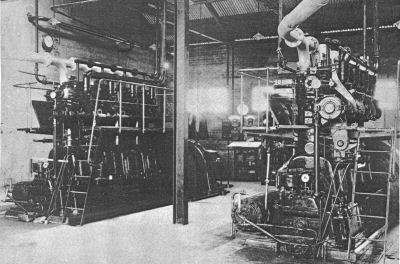
Illustration of the two 4VKE engines installed at Port Lincoln Freezing Works,
from a book on lubricating oils published by the Shell Oil Company in the 1930s.
According to the caption under the photograph they were each rated at 240 bhp.
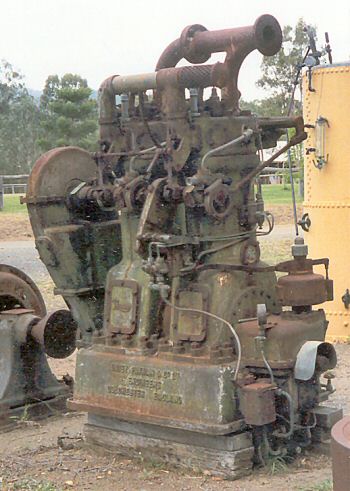 2VFE Engine, No 23735 (1931), Emerald Power Station
2VFE Engine, No 23735 (1931), Emerald Power Station
When the photograph on the right was taken in November 2001 the engine was standing outside, with the flywheel lying beside it, at Rockhampton Heritage Village (RHV), Queensland, about 150 miles north of Bundaberg. The effects of prolonged exposure to the elements are only too evident. As the maker's plate, carrying the engine's number, had been removed it was not possible to match the engine to a Paxman order until 2010.
In April 2010 an email was received from Ralph Walker, a Friend of the RHV. After becoming involved at the Heritage Village, Ralph covered as much of the engine as he could to protect it from the weather and aimed to get it under cover with a view to restoration. The cylinders had been filled with diesel and oil but Ralph was sure that No 2 cylinder had had a good deal of rain down it in the past. He reported that the oil in the sump was very clean with no sign of water which was encouraging. Also, none of the engine's components appeared to be cracked or broken. In April 2010 the engine was moved into a shed, under cover. Up to that time the RHV management had considered the engine to be for 'static display only', never to be restored. However, from that time there were hopes that the engine could be brought back into working order. By 2017 a restoration project was under way. The Paxman Archive Trust supplied RHV with a copy of the relevant instruction manual for the engine and images of VF and VFE engineering drawings.
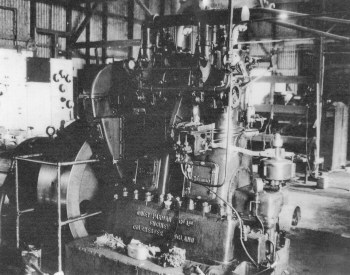 The RHV's management established that the engine, which is believed to have been donated by the Hinz family, came from the power station at Emerald, about 150 miles west of Rockhampton. On the basis of this information, the photographs received in 2002 and a study of Paxman order records, there is no doubt the engine is No 23735, a type VFE of 8½" bore and 12" stroke, built under Paxman Order No 17705 of 8th December 1930. The surviving copy order book shows it was despatched from the Colchester factory on 25th February 1931 to Noyes Bros, Brisbane (Paxman's agent in Australia) for the Emerald Lighting Co.
The RHV's management established that the engine, which is believed to have been donated by the Hinz family, came from the power station at Emerald, about 150 miles west of Rockhampton. On the basis of this information, the photographs received in 2002 and a study of Paxman order records, there is no doubt the engine is No 23735, a type VFE of 8½" bore and 12" stroke, built under Paxman Order No 17705 of 8th December 1930. The surviving copy order book shows it was despatched from the Colchester factory on 25th February 1931 to Noyes Bros, Brisbane (Paxman's agent in Australia) for the Emerald Lighting Co.
Left: The 2VFE installation at Emerald Power Station.
The switchboard with its meters is visible in the background.
At Emerald the engine was coupled to a Crompton Parkinson shunt wound DC generator and a Crompton Parkinson 3 phase alternator, each designed to run at 500 rpm. Both are now with the engine at RHV and carry Noyes Bros agent's plates. The rating plates show that the DC generator, No F81A557, is rated 35/60 volts, 37 amps and the alternator, No 157465, is rated 50kVA, 50 cycles, 415/440 volts, 69.5 amps.
In December 2015 Ralph Walker photographed what he believe to be the switchboards from the Emerald power station when powered by the Paxman 2VFE. These were found in a storage yard and made from two-inch thick marble. One was about 4' 6" long but at some time a large pipe had been dropped on it, breaking it in two. Disappointing, but Ralph considered it repairable. He made arrangements for the boards to be removed and stored with the engine.
Up to that time Ralph's aim had been to preserve the engine for possible restoration in the future. Now he was asked to put forward a plan, with estimated costs, for restoring it. The timing was opportune in that a new engine shed was then being completed at the village.
In December 2015 Ralph emailed to say the internals of the engine looked good, with clean oil. The only internal damage was to the exhaust valve on one cylinder head caused by a possum making its home in the exhaust manifold and 'wetting its bed'. The possum was unknowingly drowned when Ralph had filled the manifolds with a 50/50 mixture of diesel and oil and sealed it with a tin can when he first arrived at the village in December 1999. At that time the engine was under a gum tree. The possum's little carcass was not discovered until Ralph had got the engine under cover about ten years later and started to examine the condition of the engine more closely.
At a meeting with the management of the RHV on 20th December 2016 it was decided that the time had come to put together a plan to restore and display the Paxman engine. Two volunteers, one a fitter with heavy diesel experience and the other a mechanic, were interested in joining the project and the management agreed to prepare a grant application in the new year for funding of the restoration.
On 24th January 2017 Ralph emailed to say a start had been made on the engine's restoration. The electrical switchboards had been recovered and the engine moved under a beam strong enough to take the weight of the cylinder heads when lifting them off. Scaffolding had been erected around the engine. The two volunteer mechanics would be doing the restoration with Ralph in an advisory role and recording progress. The management of the RHV were due to start on the grant application in early February. On 7th February Ralph emailed me some more pictures of work in progress including the one below.
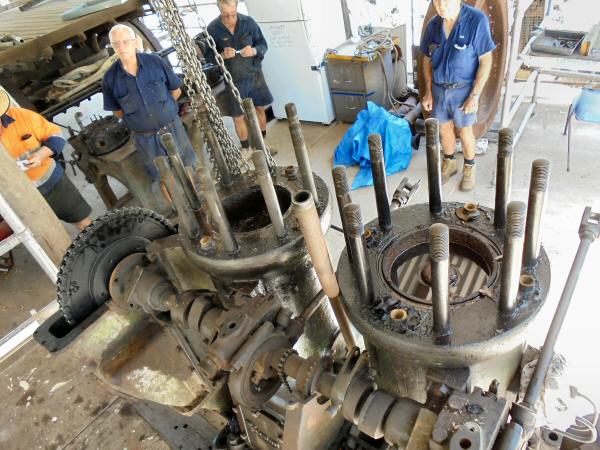
Restoration work in progress at Rockhampton Heritage Village in February 2017
The 2VFE with its cylinder heads removed.
It was most encouraging to learn that the restoration of this rare engine was under way and great credit must go to Ralph for his efforts in pressing for its preservation. The engine and alternator are a real part of the heritage and history of this part of Queensland. The opening of the Emerald power station and the coming of electric lighting must have caused quite a stir in Emerald in 1931.
On 3rd October 2017 Ralph emailed a further update. After eight months of trying, in August one piston had been removed from its cylinder liner. Considerable problems were encountered in attempting to remove the second piston. It was decided to mount the engine and fit the flywheel, turning the latter to apply force to shift the second piston. The volunteers succeeded in releasing the cylinder liner but with the piston still stuck inside it. At the beginning of October they were trying various ways to free the piston from its liner.
A week later, on 10th October, Ralph reported that because the second piston was so firmly stuck in its liner, they were heated to red hot in a fire pit for ten hours. The pit was then covered with 12 inches of soil and it took 19 days to cool enough for the liner and piston to be handled. After that they were soaked for a week in a mixture of transmission oil and diesel. Finally, the piston was successfully removed from its liner. It had taken the team from January to October to remove both pistons from their liners.
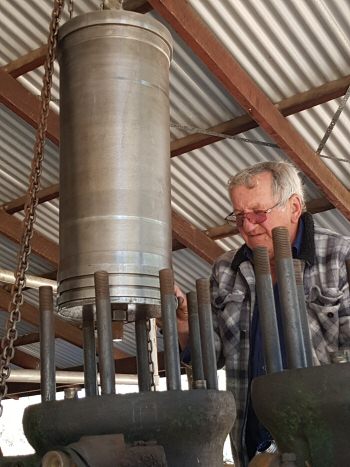 On 20th November 2017 Ralph received the good news that the 'Friends of the (Rockhampton Heritage) Village' had granted him AUD$10,000 to spend on the engine's restoration. Advice received was that it would be cheaper to have new cylinder liners cast and machined, than to re-sleeve the old ones. Although cheaper, it would not be cheap. Quotes for casting new liners were around AUD$2,000 per liner, on top of which there would be transport and machining costs.
On 20th November 2017 Ralph received the good news that the 'Friends of the (Rockhampton Heritage) Village' had granted him AUD$10,000 to spend on the engine's restoration. Advice received was that it would be cheaper to have new cylinder liners cast and machined, than to re-sleeve the old ones. Although cheaper, it would not be cheap. Quotes for casting new liners were around AUD$2,000 per liner, on top of which there would be transport and machining costs.
On 9th January 2018 Ralph emailed to say that the second liner was finally out of the engine thanks to the efforts of Dave McGaun, Greg Holgate, and Paul Green. That day he had heard the castings for the new liners were already at Ashton Engineering and machining had begun. Also that day, Jack Ashton of Ashton Engineering was at RHV taking measurements of the cylinder block. Ralph felt they were well on the way with the engine's restoration. He commented that it was exactly a year to the day since they had started on the project.
Ralph sent a further progress report 29th August 2018. The two new cylinder liners had been installed along with the original pistons (with new piston rings) and connecting-rods. The cylinder heads were being completely disassembled. What was seen was very encouraging. Only minor damage had been caused by the possum that was found inside one of the exhaust valve chambers. It appeared that the valve had been shut, limiting the minor damage to just one valve chamber.
Left: Greg Holgate guides one of the new cylinder liners into its cylinder casting
on 14th August 2018.
Those carrying out the restoration faced engineering challenges they could never have anticipated. In April 2019 I had some very interesting email correspondence with Dave McGaun, one of the fitters working on the project. He explained that at some stage there must have been a serious engine failure. The dome on top of one of the pistons had been damaged and the previous owners had cast a new one and bolted it to the top of the piston. Unfortunately the new dome was higher and a larger diameter than the dome on the other piston. On this same cylinder the connecting rod was bent, most likely from when the piston was damaged. The RHV team were unwilling to straighten the con-rod because to do so might weaken it. The engine had been assembled with over an eighth (1⁄8) of an inch difference in piston to head clearance between each cylinder and the cylinder with the bent rod had the least clearance. The previous repairers had used different thickness head gaskets and different thickness shims beneath each con-rod. At one stage new big end bearings must have been manufactured and the oil grooves were not lined up to deliver oil to the small end so they had ground a groove in the bearing to let oil to the con-rod feed to the little end. As Dave remarked, the engine has had a very interesting history.
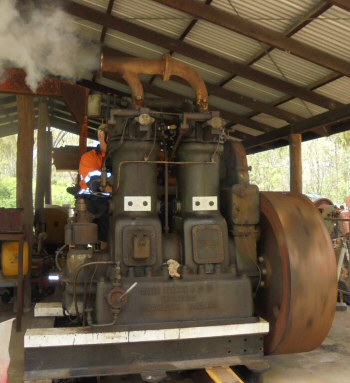 Dave went on to say everything they touched was seized or damaged or rusted away. The fuel injector pumps had been overhauled and a new drive gear manufactured. At the time they were working on the governor and trying to work out why it was driven by a friction disk. The next components to overhaul were the injectors which had been soaking in penetrol for a couple of months.
Dave went on to say everything they touched was seized or damaged or rusted away. The fuel injector pumps had been overhauled and a new drive gear manufactured. At the time they were working on the governor and trying to work out why it was driven by a friction disk. The next components to overhaul were the injectors which had been soaking in penetrol for a couple of months.
It was naturally a concern to Dave that they had to rebuild the engine using a bent connecting rod and different size pistons etc. Undaunted, he told me not to worry. He and his colleagues would continue to work with what they had and eventually get to the point when they could fire the engine into life again.
Ralph emailed me on 10th March 2020 with the excellent news that the engine had been started up for the first time that day. It ran for 10 minutes before it was stopped for some adjustments, and then run for another 10 minutes. It ran very sweetly. In Ralph's words: 'It sat there smooth as silk'.
Right: The partly restored 2VFE engine runs for the first time at the RHV on 10th March 2020.
Exhaust smoke is visible in the top left of the picture.
The plan at March 2020 was to move the engine and install it properly now that they knew it would run. They had to guess the fuel injector and pump springs as there wasn't much left of them and the ball bearings inside. There was still a lot to do.
Looking back at the state of the engine in early 2010 when Ralph saw it, covered it up to protect it from the weather, and aimed to get it under cover with a view to restoration - and all the challenges faced during the restoration - what he, Dave and the rest of the team achieved was truly remarkable.
Acknowledgement: I am most grateful to Ralph Walker and Dave McGaun for keeping me so well informed about the project as it progressed. My hearty congratulations to all who were involved in bringing this engine back to life and preserving it for future generations.
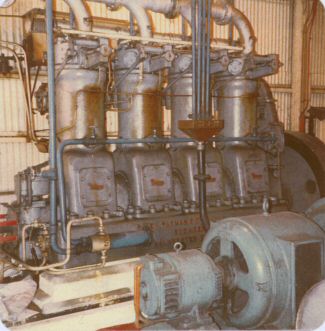 4VHE Engine, No 24337 - built in 1934
4VHE Engine, No 24337 - built in 1934
This four cylinder engine was sold through Noyes Brothers of Sydney, possibly through their Brisbane office, to the Millaquin Sugar Company for the Millaquin Rum Distillery at Bundaberg, Queensland. Noyes Brothers were also the agents for some of the other engines listed above.
Pictured right is the engine as it was when installed in the engine room at the Millaquin distillery. No 24337 was still in use in 1984 when Tony Marvin visited the plant.
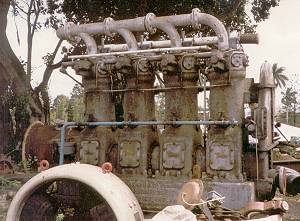 In a letter published in the April 1992 issue of 'Stationary Engine', Tony reported the engine had recently been removed and was lying outside exposed to the weather. He appealed for some organisation to secure the engine for preservation. Shown left is the engine in the redundant machinery scrap area at Bundaberg.
In a letter published in the April 1992 issue of 'Stationary Engine', Tony reported the engine had recently been removed and was lying outside exposed to the weather. He appealed for some organisation to secure the engine for preservation. Shown left is the engine in the redundant machinery scrap area at Bundaberg.
As at 2010 the engine was owned by Robert Hursthouse, an engine enthusiast, of Gin Gin, Queensland.
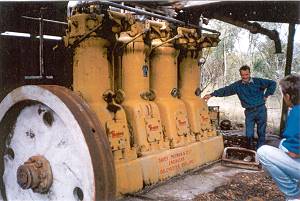 4-Cylinder VKE Engine
4-Cylinder VKE Engine
The four cylinder engine pictured on the right finished its working life at the Webbs Silver Mine, about ten kilometers northwest of Emmaville, near Glen Innes, NSW. It was bought second-hand, taken to the mine in pieces, and re-assembled there in 1940. It possibly came from the Norco Butter factory at Byron Bay about 100 miles away; if so, it is No 23972. The mine closed in 1960.
The pictures, right and below, were taken in the early 1990s. Apparently there were plans to remove the engine to a local museum and set it up on permanent display but as at 2012 it was still where it was installed in 1940.
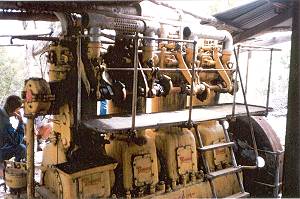 It had been hoped we could establish the engine's number and look up the original order details. Sadly someone has removed the maker's plate which would have had the number stamped on. Consequently it is going to be much more difficult to identify the engine with certainty. If it is not No 23972 then it must be either No 23549, 23617 or 23681. Does anyone out there have any information on where the engine was installed originally? - if so, do please contact me.
It had been hoped we could establish the engine's number and look up the original order details. Sadly someone has removed the maker's plate which would have had the number stamped on. Consequently it is going to be much more difficult to identify the engine with certainty. If it is not No 23972 then it must be either No 23549, 23617 or 23681. Does anyone out there have any information on where the engine was installed originally? - if so, do please contact me.
In the picture to the left, at the free end, one can see the vertical shaft which drives the camshaft. The latter can be seen just above the staging and above that the large operating levers for the spring injection system.
There were other Ruston horizontal engines in the shed at the mine but these have now gone.
Paxman Heavy Duty Diesel Engines
For a history and description of this type see the page Heavy Duty Diesel Engines. Orders for Paxman Heavy Duty Diesel Engines sent to Australia included the following:
| Engine Type | Number | Customer/End User | Location/Notes |
|---|---|---|---|
| 5 VZ | 23973 | Noyes Bros (Brisbane) for Warwick Co-op. | Warwick. Sent 7 Oct 1932. |
| 5 VZ | 24054 | Coates & Co Pty Ltd (99 Queen Street, Melbourne C.1) for Sanitarium Health Food Co Ordered 22 Nov 1932. | Warburton, Victoria. Sent 21 Mar 1933. As at April 2014, in preservation with the Central Goldfields Historic Machinery Society at Dunolly, Victoria (see more below). |
| 2 VZ | 24412 | Coates & Co Pty Ltd. | Sent 9 Oct 1934. |
| 4 VZ | 24413 | Coates & Co Pty Ltd for Griffith Producers' Co-op Co Ltd, NSW. | Sent 2 Oct 1934 Used by the Griffith Producers' Co-op from 1934 to 1965 to power refrigeration plant. Now in preservation at the Pioneer Park Museum, Griffith, NSW. (see more below) |
| 7 VX | 24415 | Flower, Davies & Johnson Ltd for West Australian Newspaper Co. | Sent 27 Nov 1934. |
| 3 VZ | 24564 Order No 18534 | Noyes Brothers (Sydney) Ltd | This is most probably the 3VZ engine purchased by David Rossington, of Tamworth, NSW, in 2017. (see more below) |
| 4 VZ | Order No 18595 | Noyes Brothers (Sydney) Ltd for Metropolitan Water Board, Sydney. | |
| 4 VZ | Order No 18596 | ||
| 5 VZ | 24716 | Noyes Brothers (Sydney) Ltd for a Public Works Department | |
| 6 VZ | 24717 | Noyes Brothers (Sydney) Ltd. | |
| 5 VZ | Order No 18689 | Noyes Brothers (Sydney) Ltd | |
| 5 VY | Order No 18722 | Noyes Brothers (Sydney) Ltd |
Surviving Paxman Heavy Duty Diesel Engines
I am aware of only three surviving Paxman Heavy Duty Diesel engines, all three of which are in Australia.
No 24054 - built in 1933
A five cylinder Type VZ engine, No 24054 was ordered in November 1932 by Coates & Co Pty Ltd of Melbourne for the Sanitarium Health Food Company at Warburton, about 40 miles east of Melbourne. Built under Order No 18024, it was despatched from the Colchester factory on 21st March 1933 and had a rating of 125 bhp at 750 rpm. At Warburton the engine ran in parallel with a 350 bhp hydro-electric plant. In a book on lubricating oils, published by the Shell Oil Company in the 1930s, there is a photograph of the engine installed at Sanitarium's factory. The caption underneath includes the words "Coupled to 83 K.W. Lancashire D.C. Generator". The caption under another photograph in the same book notes that the engine is fitted with the Paxman-Bosch Fuel System (which superseded the spring injection system previously used by Paxman on its oil engines). Separate gear pumps supplied oil to the bearings and camshaft and a separate sump was fitted for the camshaft lubrication oil supply. The camshafts were driven by a silent roller chain with automatic tension adjustment.
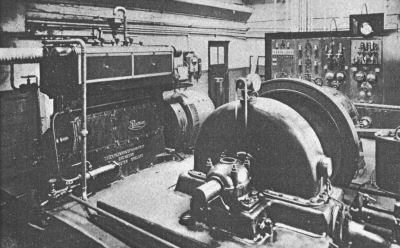
Illustration of No 24054 installed at the Sanitarium Health Food Company, Warburton,
shown in the Shell Oil book mentioned above.
With the help of Terry Jenkins, Barry Cureton and Brian Culley in Australia it has been possible to compile a relatively detailed history of the engine.
Terry Jenkins of Melbourne doggedly pursued enquiries into the local history of the engine. He was eventually successful in tracking down a copy blueprint General Arrangement drawing by Davey Paxman & Co (Colchester) Ltd which is dated 3-12-32 and carries Reference No 20376. The drawing was done for the agents, Messrs Coates & Co Pty Ltd. Terry also managed to find a three page report on the Warburton Hydro Electric Plant dated 14th November 1960. This confirms that the engine was installed in 1933 with a direct coupled 83kW 250 volt DC generator. Sanitarium built a new factory at Warburton in 1937 and the 5VZ was transferred to it in 1938. At this point the DC generator was replaced by an 83kW, 415 volt, 3 phase, 50 cycle alternator. During 1954, after more than twenty years service, the Sanitarium Health Food Company replaced the Paxman 5VZ with an 8 cylinder 420 hp Mirrlees driving a 285 kW alternator.
After being removed from the Sanitarium factory in 1954, the 5VZ and alternator were installed in the Hollandia Shoe factory at Lilydale, on the eastern outskirts of Melbourne, about 22 miles west of Warburton. In late 1981, possibly in December, Barry Cureton removed the generator set, in sections, from the Hollandia factory and took it to his workshop at Croydon. The shoe factory was about to be demolished and the site redeveloped with shops and small factory units. Barry remembers being told at the time that the generator set had been at Warburton previously and that it had been at Lilydale since the mid-1950s. This fits with the information that the engine was replaced at Warburton in 1954.
When Barry took the engine out of the Hollandia factory, it had not run for a while. Some contractors had serviced the engine in mid-1981, after which it was impossible to start. Barry and his colleagues resolved the problems after working out the correct direction of rotation, the firing order (13542 - No 1 nearest flywheel), cam timing and the operating sequence of the Bosch fuel pump. Barry's records show that the engine had air starting and was coupled to a 105 kW, 3 phase, 50 cycle, 180 amp alternator. The 105 kW rating is different from the 83 kW rating, quoted above, of the alternator fitted in 1938. Barry queries whether the quoted 83 kW rating was incorrect and should have read 105 kW.
In mid-1982, after overhaul by Barry and his team, the engine and alternator were installed at a gold mine at Tarnagulla, Victoria, about 100 miles north west of Melbourne. Brian Culley of the Central Goldfields Historic Machinery Society emailed in April 2014, saying that the mining company donated the engine to this society in mid-1995 when the mine closed. At that time the Society had no storage of its own so the engine was stored at a local caravan park until that also closed. Maryborough Council then agreed to keep it at their depot. The picture below is of the engine, coupled to its Lancashire alternator, while stored at Maryborough Council's depot, about 20 miles south of Tarnagulla. Although the maker's plate had been removed, there is no doubt it is No 24054. The fabricated underframe is identical to that in a photograph, taken by Barry, of the engine under load at the gold mine in 1982.
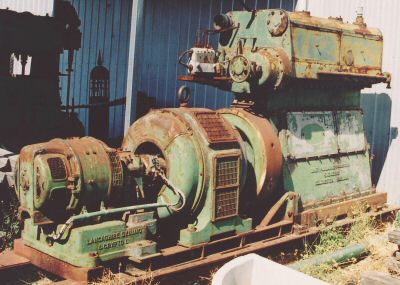
No 24054 while stored at Maryborough Council depot.
Brian Culley reported that as at April 2014 the engine was at the CGHMS's premises at Dunolly, about half-way between Tarnagulla and Maryborough. It was still in the condition seen in the picture above. The good news was that it still turned over but needed some minor work and parts. The Society's plan was to have it running again at some time in the future.
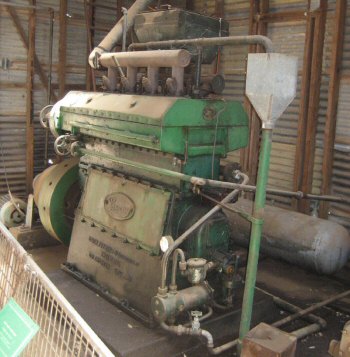 No 24413 - built in 1934
No 24413 - built in 1934
To the best of my knowledge, No 24413 is the only surviving Paxman Heavy Duty Diesel Engine still in working order. This four-cylinder Type VZ was ordered in 1934 by Coates & Co Pty Ltd for the Griffith Producers' Co-op Co Ltd.
The engine was built under Paxman Order No 18383 of 22nd July 1934. In the surviving copy order book the engine speed is recorded as 800 rpm and the date of despatch from the Colchester factory as 2nd October 1934.
Right: No 24413 at Pioneer Park Museum, Griffith, NSW.
Information displayed with the engine at the Pioneer Park Museum includes the following: 106 HP 800RPM.
The engine was purchased new by the Griffith Producers' Co-operative in 1934 to drive the 50 ton ammonia compressor used in cool room fruit storage.
The engine was in regular use from 1934 to 1965 ensuring fruit was kept in pristine condition for transport and marketing.
In the summer of 1938-39 a severe heatwave struck Griffith for weeks on end and the temperature soared above 100 degrees (F). Children and adults at risk were transported from the hospital to the Griffith Producers' cool rooms.
Used by the Griffith Producers' Co-op from 1934 to 1965 to power refrigeration plant, it is now in preservation at the Griffith Pioneer Park Museum, Griffith, NSW.
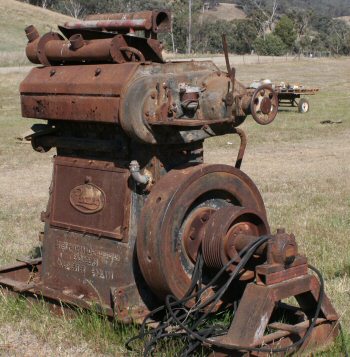 No 24564 - probably built in 1935
No 24564 - probably built in 1935
It is believed the 3VZ described here is No 24564 but the identity of the engine remains subject to verification. Unfortunately the maker's plate is missing from the engine and, as yet, it has not been possible to find an engine number stamped on any of its components. The only record we have of a 3VZ exported to Australia is that ordered by Noyes Brothers (Sydney) Ltd, built under Paxman Order No 18534, and which would almost certainly have been given Engine No 24564. Regrettably there are no surviving Paxman order records for the period during which this engine would have been ordered and despatched.
The engine was purchased by David Rossington, of Tamworth, NSW, at a clearing sale in late September 2017. David emailed to say the engine had had a hard life and is missing a few bits, as is evident from the photograph shown here.
Right: No 24564 at the clearing sale in September 2017 Photo © David Rossington 2017
David was unable to say where the engine came from originally. In 1987 it was located at Dayal Singh Construction's storage yard in Tamworth. When that yard was cleared, some time between 2007 and 2010, the engine was bought by the owner who held the sale at which David bought it. Nothing had changed except that some bits had been removed. David was able to purchase the Bosch 3-cylinder injector pump that had been removed some years ago and which he spotted perched on an oil drum near a workshop. An injector and rev counter were also among sundry items at the sale. It is indeed fortunate that these original parts have been reunited with the engine.
While doing some initial work on the engine David noted that it had only ever been painted black, with the Paxman badge on the crankcase doors and the lettering cast into the bedplate finished in red. The edges of the crankcase doors had been lined out in white or cream.
I have suggested to David it could be useful for him to visit the Griffith Pioneer Park Museum and view the 4VZ engine there. The 4VZ is in working order and will be virtually identical to the 3-cylinder variant apart from its extra cylinder.
RQ, RW, and RX Engines
| Engine Type | Number | Customer/Operator | Location |
|---|---|---|---|
| 2 LRQ | 540 | Terania Shire Council | |
| 4 RQ | 9273 | Metalcraft Engineering | Alexandria |
| 5 RQ | 550 | Chemical Elect Co | Mascot |
| 6 RQ | 1460/1 | Cockatoo Dock | Sydney |
| 6 RQE | N/K | in a North British locomotive | somewhere in Northern NSW |
| 4 RW | 700120/10 * | Enterprise Foundry | Sefton |
| 5 RW | 5564 | P.M.G | Newtown |
| 5 RW | 5565 | P.M.G. | Ashfield |
| 5 RW | N/K | P.M.G. | North Sydney |
| 6 RW | N/K | F Dickin | |
| 6 RW | 1146 | Station 2CY | Canberra |
| 6 RW | 6922 * | F J Palmer | West Maitland |
| 6 RW | 6946 * | Egg Board | Sydney |
| 6 RW | 7746 | M.L. Engineering | Redfern |
| 6 RW | 700251/3 | Commonwealth Wool & Produce | |
| 6 RW | 4154 * | Metal Protectors | Granville |
| 6 RW | N/K | Bern Shipping Co | |
| 8 RW | 1223 | Dept of Navy | HMAS Narimba. This engine was on a cast iron base driving a large Pulsometer pump. Air start. Used initially for emptying dry or floating docks. |
| 6 RX | 50864 | Lamport & Holt Ltd. | "Oakland Star" |
[ RQ/RW/RX - descriptions and technical details ]
RPL Engines
| Engine Type | Number | Customer/End User | Location/Notes |
|---|---|---|---|
| 5 RPL | 700264/2 * | Wendouree (Myer's) Woollen Mill | Ballarat, Victoria. |
| 6 RPL | 000033/4 * | Department of Works / Royal Australian Air Force | Brookvale, NSW |
| 6 RPL | 700268/2 * | Ford Motors | Homebush, NSW |
| 6 RPL | 700268/3 * | David Jones | Surry Hills |
| 6 RPL | N/K * | R B Davies | Marrickville |
| 6 RPL | N/K | "Morning Star" Gold Mine | Woods Point, Victoria |
| 6 RPL | N/K | "Gaffney's Creek" Gold Mine | Gaffney's Creek, Victoria |
| 8 RPL | 700269/1 * | Larke Hoskins | Sydney |
Tony Marvin worked on the two gold mine engines in Victoria. He remarked that they had bad fuel problems in 1947 because "we got a lot of rubbish in fuel in those days".
The 5RPL listed in the above table was purchased in September 2003 by Terry Jenkins of Melbourne for restoration and preservation. A naturally-aspirated engine with a rating of 56 bhp per cylinder at 600 rpm, Engine No 700264/2 Serial No 586, weighs 7¾ tons (7,891 kg). It was originally purchased by Wendouree (northern suburb) Woollen Mill, Ballarat, Victoria, known locally as Myer's Woollen Mill. The operator's manual for this engine was issued on 27 April 1951.
The 6RPL, No 000033/4, is believed to have been built in 1951. The generator set was purchased from the Royal Australian Air Force at 'Beacon Hill' near Brookvale, North Sydney by Pemara Packing for Aus$18,000 in 1974-5. It was shipped by road to Melbourne and installed at Pemara's 35 Henderson Road, Clayton North plant until 1982 when the factory and generator were moved to 274 Ferntree Gully Road, Notting Hill, about a mile away. In the 1990s the engine failed after lubricating oil was contaminated by water leaking from cylinder seals resulting in damage to bearings and crankshaft. Macfarlane Generators were called in to quote on repairs but no work was put in hand. The unit was eventually given to the Lake Goldsmith Steam Preservation Association Inc who shipped it to Lake Goldsmith, west of Ballarat. The engine was purchased by Terry Jenkins (who also owns the 5RPL described above) in late 2003. With the help of some friends, Terry undertook the major logistical task of moving the unit, at the end of February 2004, nearer his home in Melbourne ready for restoration work to be carried out.
5RPL Engine at Hobart, Tasmania
In 2018 another surviving 5RPL engine was brought to my attention by Geoff Andrewartha. Coupled to an alternator, it is part of a standby generator set installed in the former headquarters of the "Mercury" newspaper at Hobart, Tasmania. Alongside the 5RPL is a small Ruston-Hornsby Power Starter engine, size 6 PS. In 2015 or 2016 the building was sold to new owners who are understood to be planning a gallery of some sort in the former engine room. Because of the logistical difficulties facing any attempt to remove the 5RPL from the building, the two engines are being left in place as displays in the gallery.
The engines appear to have been supplied through Ruston & Hornsby (Australia) Pty Ltd. The Paxman maker's plate on the 5RPL gives its power output as 192kW at 600 rpm.
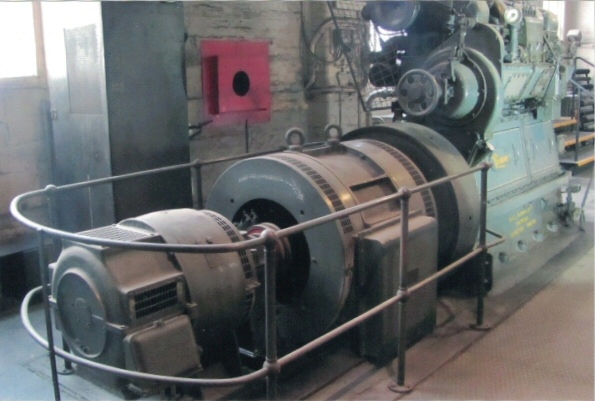
The 5RPL Generator Set in the former 'Mercury' headquarters building at Hobart
Photo © Geoff Andrewartha 2018
There are some surviving documents relating to the 5RPL. One is a sheet of paper headed 'Emergency Electrical Plant' with a valuation as at 1st July 1945 and the following description:
AC Generator (purch. with Diesel eng.)
(Cost £450 Feb. 1942)
Another sheet of paper headed 'Maintenance Schedule' includes the following notes:
Full Load 316 Amp 240kVA .8PF (Power Factor) 192kW
Run 260 Amp 150-180kW.
There is also an RPL Instruction Manual. On the cover is written: "Property of Sutex Pty Ltd, 49 Coppin St, Richmond E1, Victoria". This suggests that possibly the engine was acquired second-hand from Sutex. If you can cast any light on this please do contact me.
[ RPL - description and technical details ]
RPH Engines - 6 Cylinder
| Engine Type | Number | Customer/End User | Location/Notes |
|---|---|---|---|
| 6 RPH | 50933 | Australian Petroleum | Port Moresby |
| 6 RPH | 50934/5/6/7 4 engines | Australian Petroleum | Aramia |
| 6 RPH | 50938 | Australian Petroleum | Port Moresby |
| 6 RPH Series II | 400014/29 | A.W.A. | Gore Hill |
[ RPH - description and technical details ]
RPH Engines (Z = Marine Auxiliary)
The following details were copied from Tony Marvin's old record book. All the engines in this table are pre-1960.
| Engine Type | Number | Customer/End User | Location/Notes |
|---|---|---|---|
| 12 RPH | 000046/33 Z | Royal Australian Navy | "Arunta" |
| 12 RPH | 000046/44 Z | Royal Australian Navy | "Arunta" |
| 12 RPH | 000046/47 Z | Royal Australian Navy | "Queenborough" |
| 12 RPH | 000046/75/6/7 Z | Royal Australian Navy | |
| 12 RPH | 000046/88 Z | Royal Australian Navy | "Warramunga" |
| 12 RPH | 000046/92 Z | Royal Australian Navy | "Warramunga" |
| 12 RPH | 700196/9 * | Glen Innes Municipal Council | NSW |
| 12 RPH | 700198/40 * | Metters Ltd | Alexandria |
| 12 RPH | 700260/22 * | Australian Petroleum | Omati |
| 12 RPH | 700260/24 * | Australian Petroleum | Omati |
| 12 RPH | 800045/4 * | Metters Ltd | Alexandria |
| 12 RPH | 900001/24 * | Metters Ltd | |
| 12 RPH | 900001/25 | A.G.E. | Auburn |
| 12 RPH | 900001/26 | Coconut Products | Rabaul |
| 12 RPH | 900001/28/9 * | Metters Ltd | |
| 12 RPH | 900001/30 | Coconut Products | Rabaul |
| 12 RPH | 900001/38 * | Ford Manufacturing | Homebush |
| 12 RPH | 900001/41 * | A.G.E. | Auburn |
| 12 RPH | DP52912-3 Z | Royal Australian Navy | |
| 12 RPH | DP52381-2-3 Z | Royal Australian Navy | |
| 12 RPH | DP52387/8/9 Z | Royal Australian Navy | |
| 12 RPH | DP52200 Z | Royal Australian Navy | |
| 12 RPH | DP52090-1-2 Z | Royal Australian Navy | |
| 12 RPH | DP51967/8/9 Z | Royal Australian Navy | |
| 12 RPH | DP52258/9 | Royal Australian Navy | |
| 12 RPH | DP52260/1/2 | Royal Australian Navy | |
| 12 YHAZ | DP53755/7 | Royal Australian Navy |
All the Metters' engines were later bought by The 600 Group (George Cohen Sons & Co) and resold overseas.
Bob Mills took delivery of No 700196/9 in spring 2005. Geoff Swilks had acquired it previously about 17 years ago from Ashford Power Station to power the induction furnace at his foundry, north of Armidale. Geoff decommissioned it as it had insufficient power and was expensive to run, after which the engine stood outside for about 15 years. Bob is confident of getting it running again with a minimum of work despite the fact it was seized when he took delivery. Paxman records show that this engine is an RPH Series I which was built by Paxman into a 330 kVA generator set with a BTH alternator. It was ordered on 28th June 1948 by Ruston & Hornsby, Brisbane, through Ruston & Hornsby, Lincoln. It was despatched on 11th March 1949 and the eventual customer is recorded as Glen Innes Municipal Council, NSW. The contract records say the engine was to be reconditioned to "as new standards" which would imply that it was built from a 12TP engine as were many other RPH Series I engines. It is not recorded which 12TP engine was used or what its previous history was.
RPH Series I
| Engine Type | Number | Customer/End User | Location/Notes |
|---|---|---|---|
| 12 TPM 2 engines | 900001/30 | Coconut Products | Rabaul. (The TP was Paxman's wartime engine from which the RPH was developed.) |
| 12 RPH | 900001/45 | Royal Australian Navy | "Voyager" |
| 12 RPH | 900001/46 | Royal Australian Navy | "Voyager" |
| 12 RPH | 900001/47 | Royal Australian Navy | "Voyager" |
| 12 RPH | 000046/45 | Royal Australian Navy | "Queenborough" |
| 12 RPH | 000046/46 | Royal Australian Navy | "Queenborough" |
| 12 RPH | 000046/48 | Royal Australian Navy | "Quadrant" |
| 12 RPH | 000046/49 | Royal Australian Navy | "Quadrant" |
| 12 RPH | 000046/50 | Royal Australian Navy | "Quadrant" |
| 12 RPH | 000046/89 | Royal Australian Navy | "Quick Match" |
| 12 RPH | 000046/124 | Royal Australian Navy | "Quick Match" |
| 12 RPH | 000046/125 | Royal Australian Navy | "Quick Match" |
| 12 RPH | 000035/9 | Royal Australian Navy | (not in use) |
| 12 RPH | 000035/10 | Royal Australian Navy | (not in use) |
| 12 RPH | 000035/11 | Royal Australian Navy | (not in use) |
RPH Series II Engines in NSW 41 Class Locomotives
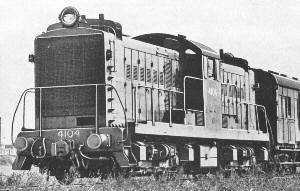 Information on the locomotive engines listed in the table below was supplied to Tony Marvin on 21st November 1956 by Mr Jack Lewis, Chief Engineer, New South Wales Government Railways. The engines, each rated 500 bhp at 1,250 rpm, were fitted in ten heavy Bo-Bo twin-engined diesel-electric shunters. These NSW 41 Class locomotives were built by Metro-Cammell for British Thomson-Houston and introduced in 1953-54 to handle freight transfer traffic in the Sydney area. They were not a great success and all were scrapped except No 4102 which has been preserved at the New South Wales Rail Transport Museum, Thirlmere. Information about 41 Class locomotives and No 4102 can be found on the museum's website at www.nswrtm.org/exhibits/the_exhibits/4102.html.
Information on the locomotive engines listed in the table below was supplied to Tony Marvin on 21st November 1956 by Mr Jack Lewis, Chief Engineer, New South Wales Government Railways. The engines, each rated 500 bhp at 1,250 rpm, were fitted in ten heavy Bo-Bo twin-engined diesel-electric shunters. These NSW 41 Class locomotives were built by Metro-Cammell for British Thomson-Houston and introduced in 1953-54 to handle freight transfer traffic in the Sydney area. They were not a great success and all were scrapped except No 4102 which has been preserved at the New South Wales Rail Transport Museum, Thirlmere. Information about 41 Class locomotives and No 4102 can be found on the museum's website at www.nswrtm.org/exhibits/the_exhibits/4102.html.
| Engine Type | Loco Number | "A" End | "B" End |
|---|---|---|---|
| 12 RPHL | 4101 | 000023/3 | 000023/4 |
| 12 RPHL | 4102 | 000023/2 | 000023/7 |
| 12 RPHL | 4103 | 000023/23 | 000023/1 |
| 12 RPHL | 4104 | 000023/8 | 000023/22 |
| 12 RPHL | 4105 | 000023/5 | 000023/6 |
| 12 RPHL | 4106 | 000023/14 | 000023/19 |
| 12 RPHL | 4107 | 000023/20 | 000023/9 |
| 12 RPHL | 4108 | 000023/13 | 000023/21 |
| 12 RPHL | 4109 | 000023/18 | 000023/10 |
| 12 RPHL | 4110 | 000023/17 | 000023/24 |
| 12 RPHL | spare | 000021/18 |
A 12RPHL engine for rail traction, No 500014, was also supplied to A.W.A. at Gore Hill.
RPH Series II Engine in Emu Bay Railway Locomotive
A 12RPHXL engine was supplied for a locomotive built by the North British Locomotive Co for the Emu Bay Railway in Tasmania. The locomotive was introduce into service in 1953 and was withdrawn from service in 2001. It is now in preservation at the Derwent Valley Railway, New Norfolk, near Hobart, Tasmania.
Ventura and YH
The Metcentre, at 60 Margaret Street, Sydney, has a Paxman Ventura and a YH engine driving MacFarlane alternators to supply emergency power to the building. (There is no public access to the generator sets for obvious safety reasons.) The turbo-charged Vee 12 engines were installed in 1976/77 by Stone Platt Electrical of Victoria.
The Ventura 12YJC is rated at 1,400 bhp at 1,500 rpm, and the 12YHC at 1,050 bhp at 1,500 rpm. Both are still going strong after quarter of a century's service.
Valenta and VP185 Engines for Rail Traction
Paxman supplied a total of twenty four 12 cylinder Valenta engines for the XPT (Express Passenger Train) power cars introduced into regular service by the State Rail Authority (SRA) of New South Wales in 1982. The trains proved highly successful and four more engines were ordered in 1990 for four additional power cars. For more details see the Diesel Rail Traction page.
The power cars were subsequently re-engined with the Valenta's successor, Paxman's 12 cylinder VP185 engine.
Page updated: 20 Feb 2024 at 11:43
